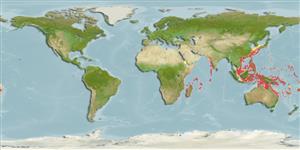>
Eupercaria/misc (Various families in series Eupercaria) >
Labridae (Wrasses)
Etymology: rubrovittatus: Named in reference to its two red stripes (Ref. 33414).
More on authors: Randall & Fourmanoir.
Environment: milieu / climate zone / depth range / distribution range
Écologie
marin démersal; profondeur 50 - 120 m (Ref. 90102). Tropical
Western Central Pacific: New Caledonia, Papua New Guinea, Indonesia, and Palau.
Taille / Poids / Âge
Maturity: Lm ? range ? - ? cm
Max length : 12.0 cm TL mâle / non sexé; (Ref. 90102)
Description synthétique
Clés d'identification | Morphologie | Morphométrie
Épines dorsales (Total) : 10; Rayons mous dorsaux (Total) : 11; Épines anales: 3; Rayons mous anaux: 12. Body elongate, depth 6.2-6.3 in SL; head and anterior body cylindrical; eye large, 3.55-4.2 in HL; interorbital space nearly flat, 5.0-5.5 in HL; two pairs of large, well-space, recurved canine teeth anteriorly in each jaw; remaining conical teeth uniserial and small except for canine at corner of mouth; distinctive red-striped pattern consisting of midlateral red stripe from front of lips, faintly through eye, and continuing to end of caudal fin and a narrow red stripe dorsally on head and body.
Deep coastal to outer reef habitats. First found in about 100 m, specimens have since been found much shallower and ranging as far north as Japan. A second new species in the genus was recently found in the Maldives (Ref. 48636). Maximum depth reported taken from Ref. 128797.
Life cycle and mating behavior
Maturities | Reproduction | Spawnings | Egg(s) | Fecundities | Larves
Oviparous, distinct pairing during breeding (Ref. 205).
Randall, J.E. and P. Fourmanoir, 1998. Terelabrus rubrovittatus, a new genus and species of labrid fish from New Caledonia and New Guinea. Bull. Mar. Sci. 62(1):247-252. (Ref. 33414)
Statut dans la liste rouge de l'IUCN (Ref. 130435)
Menace pour l'homme
Harmless
Utilisations par l'homme
Outils
Articles particuliers
Télécharger en XML
Sources Internet
Estimates based on models
Preferred temperature (Ref.
123201): 21.8 - 28, mean 26.5 °C (based on 90 cells).
Phylogenetic diversity index (Ref.
82804): PD
50 = 0.7500 [Uniqueness, from 0.5 = low to 2.0 = high].
Bayesian length-weight: a=0.00501 (0.00207 - 0.01214), b=3.15 (2.94 - 3.36), in cm total length, based on LWR estimates for this (Sub)family-body shape (Ref.
93245).
Niveau trophique (Ref.
69278): 3.4 ±0.4 se; based on size and trophs of closest relatives
Résilience (Ref.
120179): Haut, temps minimum de doublement de population inférieur à 15 mois (Preliminary K or Fecundity.).
Fishing Vulnerability (Ref.
59153): Low vulnerability (10 of 100).
